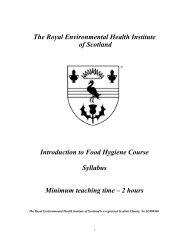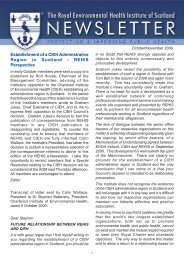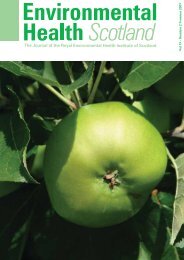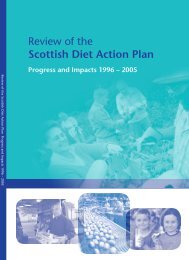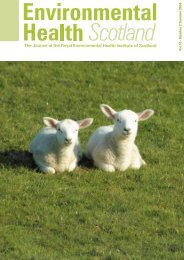Environmental Health Scotlandby Jill Buchan, Communications OfficerFOOD STANDARDS AGENCY SCOTLAND NEWSFishing Vessel Hygiene Inspection Training<strong>The</strong> Food Standards Agency Scotland (FSAS) ran aseries of courses on fishing vessel hygiene inspectionsearlier this year.<strong>The</strong>re is a requirement to inspect fishing vesselsunder the Food Law Code of Practice and thesefour courses, held in Inverness, Arbroath, Troonand Haddington, were designed to help enforcementofficers undertake safe hygiene inspections offishing vessels, encourage safe working practiceand raise awareness of potential difficulties workingin this sector.<strong>The</strong> course was constructed by FSAS and the ScottishFish Hygiene Working Group (SFHWG) alongsidethe training provider, the Fish Industry TrainingAssociation Ltd.<strong>The</strong> two-day session covered elements including:health and safety, required protective equipment,access issues and potential hazards, practicaldemonstrations and good practice, as well asconsideration of the Seafish Responsible FishingScheme and a workshop to discuss next steps for localauthorities and their specific requirements.Local Authority Enforcement Monitoring System(LAEMS)LAEMS will replace the current monitoring systemused to report local authority food and feedlaw enforcement activities to the FoodStandards Agency.LAEMS is a web-based system to which localauthorities will be able to upload data generatedfrom their local systems, on which they record dataon food and feed law enforcement activities.Following introductory training in April this year,there will be more sessions held at the beginningof next year for those using the system.National Food Safety Week<strong>The</strong> Food Standards Agency launched GermWatchduring Food Safety Week (FSW) in June this year.<strong>The</strong> Agency was the lead partner for FSW, whichran from 9-13 June. GermWatch was developedfollowing research with local authorities, consumersand schools and is the overarching brand for theFSA’s communication with consumers aboutfood safety.<strong>The</strong> ‘4 Cs’ (cleaning, cooking, chilling and avoidingcross-contamination) will continue to remain afocus for GermWatch. Of these, according to thisresearch, cross-contamination remains the mostconfusing issue.<strong>The</strong> Agency has produced a raft of publicitymaterials, including activity sheets for teachers.Food Colours and Children’s BehaviourAt its April meeting, the FSA Board discussed thepossible effects of certain food colours on children’sbehaviour and agreed advice to Ministers to helpinform the UK’s negotiating position in Europe onthe issue.<strong>The</strong> six colours are: Sunset yellow (E110), Quinolineyellow (E104); Carmoisine (E122), Allura red (E129),Tartrazine (E102) and Ponceau 4R (E124). <strong>The</strong>seadditives give colour to foods but nothing else.This discussion took place following the publicationlast September of research into these colours bySouthampton University, and in light of the reviewof this work by the European Food Safety Authority(EFSA), which was published in March.<strong>The</strong> Board agreed to advise UK Ministers that thereshould be voluntary action by manufacturers toremove these colours by <strong>20</strong>09. In addition, thereshould be work to phase them out in food and drinkin the European Union (EU) over a specified period.Current Agency advice for consumers is that parentsof children showing signs of hyperactivity are advisedthat cutting certain artificial colours from their dietsmight have some beneficial effects.<strong>The</strong> Agency’s stance is proportionate, and based onthe best available science. However, there are manyfactors associated with hyperactive behaviour inchildren other than their diet.<strong>The</strong> Board also requested that FSA advice issimplified and strengthened as much as possible.<strong>The</strong> preservative sodium benzoate was also consideredin the Southampton study. Use of this additive ismainly restricted to soft drinks. <strong>The</strong> Board decidedthat advice to Ministers and consumers should focus onthe colours used in the study, as the primary functionof sodium benzoate is as a preservative.UK Ministers will now discuss with otherGovernment departments to help inform thenegotiating position in Europe on this issue.30
Environmental Health ScotlandPublic Health and Housing Update Courseby Andrew McPherson, Chairman, Public Health and Housing Working Group<strong>The</strong> Public Health and Housing Update Course <strong>20</strong>08was presented in Edinburgh on 13 and 14 May.Due to the significant changes occurring in both thehousing and public health fields there appeared to beno better time to deliver this event and, in order tofully address all the major issues, the course was splitinto two days allowing presentations from a diverserange of speakers.<strong>The</strong> first day concentrated on the role ofEnvironmental Health Officers in public health.<strong>The</strong> morning session was opened by AlistairThomson, <strong>REHIS</strong>’s spokesperson on public healthissues. <strong>The</strong> first speaker was the ever popular DrHarry Burns, Scotland’s Chief Medical Officer,who delivered a typically impressive presentationwhich directly related the health of an individual tothe quality of their living environment. This messagewas further elaborated through a presentation byLorraine Tulloch from the Scottish Governmentwho is currently a Project Manager working on theStrategic Framework for Environment and Health.<strong>The</strong> simple message from Lorraine was that thereis still a considerable level of work to be done withinthis area and it was encouraging to recognise thatenvironmental health as a profession was playinga significant role. <strong>The</strong> practical application ofenvironmental health in a public health context wasdemonstrated through the next two presentations.John Arthur from Inverclyde Council discussed howthe profession was improving the standard of localcommunities within Inverclyde, and Evonne Tennantfrom East Dunbartonshire Council demonstratedthat environmental health was central to thelocal authority’s public health and communityplanning agenda.<strong>The</strong> afternoon session started with an update fromLucy Smith who is currently part of the Public HealthBill Team within the Scottish Government. Lucy wasable to provide the delegates with an update on thecurrent progress of the Public Health Bill and thelikely implementation date of the most significantparts. Although it was encouraging that thereis to be an expansion of the nuisance provisions andmeasures introduced to control the use of sunbeds,there was some concern expressed as to thetimescales for their introduction as it is likely thatthese measures will not become statute until late<strong>20</strong>09. Further discussion on the new nuisanceconditions and the use of fixed penalty notices fornon-compliance with public health notices wasprovided through the presentation of Stuart Grahamof the City of Edinburgh Council. In summary,Stuart welcomed the proposed new provisionsand, in particular, was confident that the fixedpenalty option was one which could provide a quickand effective alternative to prosecution. <strong>The</strong> finalsession of the day provided presentations from IanStrachan of the Scottish Government who providedan update on the current and proposed animal welfarelegislation and, finally, Bill Byers of Scottish Water.Bill provided some clarification of Scottish Water’sinvolvement with issues relative to environmentalhealth, with particular reference to defective sewers,pumping stations, SUDS and water to waste.Overall, one of the main messages from the firstday was that the quality of an individual’s healthcould be directly related to the quality of their livingenvironment. It was appropriate therefore that thesecond day would concentrate primarily on housingmatters. An overview of the main factors of thenew Housing (Scotland) Act <strong>20</strong>06 was provided byspeakers from Communities Scotland. Ian Muirheadprovided details on the new enforcement powersavailable through the new legislation. Thisincluded reference to Housing Renewal Areas andMaintenance Orders. It was accepted by Ian that thesepowers would require a different approach by localauthorities and that the Scottish Government expectedthat, initially, a degree of caution would be exercised,particularly with the Maintenance Orders, to ensure asuccessful implementation and adoption of the newpowers. Ian also provided further details on the newrequirements of the Tolerable Standard (electricalsafety and insulation) and gave practical guidanceon what would be required for a property to meetthese standards. David Bookbinder of CommunitiesScotland then provided clarification on the Schemeof Assistance and what this new approach willrequire of local authorities. Again, it was acceptedby David that a different approach would be requiredwithin this area but that it also provided greaterflexibility on how local authorities could assistwith housing issues. <strong>The</strong> conclusion to the morningsession covered the subject of gypsy travellers.<strong>The</strong> problems experienced by local authoritieswere summarised by Andrew Lamb of AberdeenCity Council and suggestions on how to resolvethese issues were given by Joan Robertson of31



